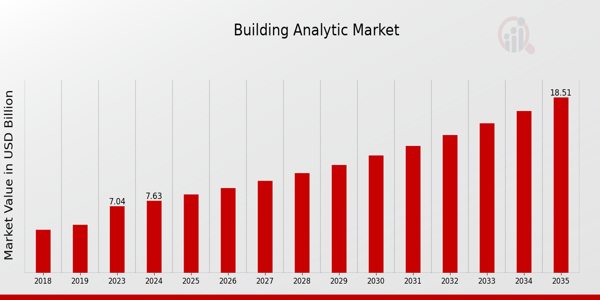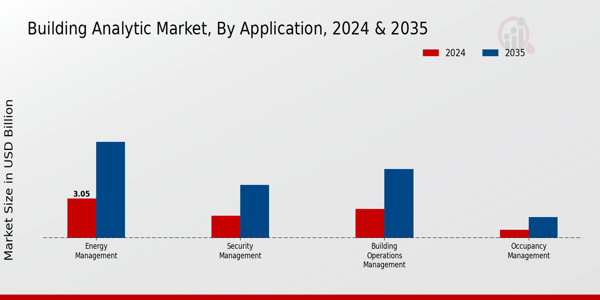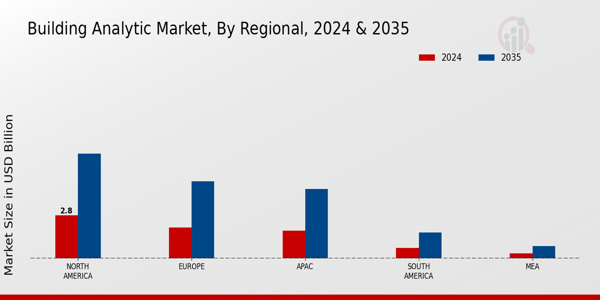Building Analytic Market Overview
Building Analytic Market Size was estimated at 7.04 (USD Billion) in 2023.
The Building Analytic Market Industry is expected to grow from 7.63(USD Billion) in 2024 to 18.5 (USD Billion) by 2035. The Building Analytic Market CAGR (growth rate) is expected to be around 8.39% during the forecast period (2025 - 2035).
Key Building Analytic Market Trends Highlighted
The Global Building Analytic Market is significantly shaped by various market drivers that support its growth. One major driver is the increasing focus on energy efficiency and sustainability in building management. As organizations strive to reduce their carbon footprint and lower energy costs, the adoption of building analytics tools has surged. Additionally, the growing demand for smart buildings, which integrate advanced technologies, has propelled the market forward. Enhanced data collection and analysis capabilities enable facility managers to make informed decisions, ultimately leading to improved operational efficiencies.
There are numerous opportunities to be explored within the building analytic domain.The integration of artificial intelligence and machine learning into analytics tools can enhance predictive maintenance, allowing for proactive energy management and reduced downtime. Additionally, the rising trend of Internet of Things (IoT) devices presents great potential. By gathering and analyzing real-time data from connected devices, building managers can optimize resource usage and improve occupant comfort. Moreover, there is an opportunity to develop customized solutions tailored to specific industry needs, such as healthcare, education, or retail, which can drive further market growth. In recent times, the market has seen emerging trends such as the increasing adoption of cloud-based analytics platforms.These platforms provide scalable solutions that allow companies to access data from anywhere, fostering remote monitoring and management of facilities. Furthermore, the emphasis on occupant experience and safety has also become prominent. Building analytics is increasingly being used to track air quality, temperature, and occupancy patterns, directly impacting tenants' well-being. As technology continues to advance, the future looks promising for the global building analytics landscape, presenting fresh avenues for innovation and efficiency.

Source: Primary Research, Secondary Research, MRFR Database and Analyst Review
Building Analytic Market Drivers
Rising Demand for Energy Efficiency and Sustainability
The Global Building Analytic Market Industry is witnessing a substantial increase in the demand for energy-efficient solutions as organizations and homeowners strive to reduce their environmental impact. This growth can be attributed to a global push for sustainability, where regulatory frameworks and building codes are increasingly emphasizing resource conservation and energy savings. Building analytics technologies offer critical insights into energy consumption patterns and help identify areas for improvement.By leveraging real-time data analytics, facilities can optimize energy usage, enhancing operational efficiency and significantly lowering costs. As countries and businesses embrace renewable energy sources and strive for carbon neutrality, the incorporation of building analytics into the design and management of buildings becomes essential.
This evolution not only meets regulatory requirements but also aligns with consumer expectations for environmentally friendly practices.Furthermore, growing awareness among businesses about the benefits of green buildings, including improved tenant satisfaction and reduced operational costs, is propelling the popularity of building analytics solutions. Enhanced energy management strategies enabled by building analytic tools allow organizations from various sectors, such as retail, commercial, and industrial, to monitor and reduce energy expenditures effectively. This trend is expected to drive the growth of the Global Building Analytic Market Industry substantially as more stakeholders adopt these technologies to comply with sustainability benchmarks and improve their bottom line.
Technological Advancements in IoT and Big Data
Technological advancements, especially in the Internet of Things (IoT) and Big Data, are significant drivers of growth in the Global Building Analytic Market Industry. With the proliferation of smart devices, buildings are becoming increasingly connected, allowing for the seamless collection of vast amounts of data. This data, when analyzed effectively, offers valuable insights that can inform better decision-making regarding building operations, maintenance and occupant comfort.As the proliferation of IoT solutions continues, integrating analytics tools with building management systems becomes more straightforward, leading to improved operational efficiencies and cost savings. This integration also allows building operators to optimize resource allocation, predicting potential issues before they escalate into costly problems.
Increased Focus on Smart Building Solutions
As urbanization accelerates, the need for smart building solutions has become more prominent, driving growth in the Global Building Analytic Market Industry. Smart buildings leverage technology to manage energy consumption, enhance occupant experience and streamline operations. Building analytics plays a crucial role in this transformation, as it enables facility managers to monitor and analyze data related to occupancy, climate control and energy usage.Rapid growth in smart building technology adoption is anticipated to drive market growth as companies strive to balance sustainable occupational comfort with operational outcomes.
Building Analytic Market Segment Insights :
Building Analytic Market Application Insights
The Global Building Analytic Market revenue, particularly within the Application segment, showcases significant growth dynamics as it continues to evolve. In 2024, the overall market value is recorded at 7.63 USD Billion and is projected to reach 18.5 USD Billion by 2035. A closer inspection of the market segmentation reveals key insights, particularly in the areas of Energy Management, Security Management, Building Operations Management, and Occupancy Management, which collectively contribute to the building’s operational efficiency.
Energy Management leads the market, holding a majority share with a valuation of 3.05 USD Billion in 2024 and increasing to 7.45 USD Billion by 2035. This sub-segment is fundamental as it facilitates real-time energy tracking and optimization, significantly reducing operational costs and contributing to sustainability efforts in buildings. The rising energy prices and increasing regulatory measures around energy efficiency are substantial growth drivers in this domain, making it a critical area for investment and development.
Security Management, valued at 1.7 USD Billion in 2024 and projected at 4.1 USD Billion by 2035, reflects the growing concern for safety and risk mitigation in building operations. This segment enables advanced surveillance, risk assessment, and response strategies, thus directly aligning with the increase in smart building initiatives and the integration of technology into security systems. The need for enhanced security measures due to urbanization and increased digital threats underpins this growth.
Building Operations Management, with a valuation of 2.25 USD Billion in 2024, rising to 5.35 USD Billion in 2035, plays a significant role in overall facility management. By optimizing building operations through data analytics and performance monitoring, this segment ensures improved operational efficiency and service delivery. The increasing complexity of building management systems and the drive towards automation are key trends enhancing the market for building operations management.
Lastly, Occupancy Management remains a smaller but significant segment, starting at 0.63 USD Billion in 2024 and expected to grow to 1.6 USD Billion by 2035. This area focuses on understanding space utilization, enhancing user experience, and maximizing productivity, thereby contributing to cost savings and efficiency. The growing trend towards hybrid workspaces necessitates effective occupancy strategies, underscoring the importance of this segment despite its smaller market share.
Overall, the Global Building Analytic Market statistics indicate a diversified approach to application segments, showcasing varied growth trajectories and the pivotal role each plays in enhancing operational efficiency and sustainability in the built environment. The interrelationship between these segments fosters a collaborative ecosystem where innovations and advancements in analytics are transforming how buildings operate and respond to emerging challenges.

Source: Primary Research, Secondary Research, MRFR Database and Analyst Review
Building Analytic Market Deployment Type Insights
This market can be further analyzed through various deployment approaches, including On-Premises, Cloud-Based and Hybrid solutions. The On-Premises deployment has historically offered organizations control over their data and security, catering well to industries with stringent compliance requirements. Conversely, Cloud-Based deployment is gaining traction due to its scalability, cost-effectiveness, and access to advanced features, making it popular among organizations aiming for flexibility.Hybrid solutions combine the best of both worlds, providing a balance of security and convenience. The demand for these deployment types is rising as enterprises seek to leverage building analytic data effectively for improved operational efficiency. Market trends suggest an increasing shift towards Cloud-Based solutions driven by the need for real-time data access and integrated analytics, thus continuing to reshape the Global Building Analytic Market landscape. These trends present opportunities for growth and innovation within the industry as organizations increasingly view building analytics as a crucial part of their operational strategy.
Building Analytic Market End Use Insights
This expansion reflects an increased focus on optimizing building performance across various End Use sectors. In the Residential segment, building analytics is driving energy efficiency and contributing to enhanced living conditions, which continues to attract considerable attention from homeowners and developers. The Commercial segment plays a crucial role as it encompasses office spaces, retail environments, and hospitality, wherein analytics facilitate improved resource management and operational efficiency.Meanwhile, the Industrial sector is leveraging building analytics for predictive maintenance and safety compliance, making it a considerable player in the market's development. The Government sector is also notable, with advancements in smart city initiatives that integrate data analytics for better infrastructure management. Overall, the Global Building Analytic Market data indicates a robust trajectory influenced by growing demand for efficient building solutions across these diverse sectors, empowering stakeholders to make informed decisions while also addressing evolving sustainability goals.
Building Analytic Market Component Insights
This segment is intricately divided into Software, Services, and Hardware, each contributing distinctly to market dynamics. Software solutions are integral to data processing and analytics, empowering organizations to make informed decisions. The Services component encompasses consulting, implementation, and support, reflecting the growing need for specialized expertise in deploying building analytics effectively.Hardware, including sensors and IoT devices, provides the essential infrastructure for data collection and monitoring. Each of these components is essential in driving efficiency and sustainability in building management, highlighting their importance in fulfilling the increasing demand for smart building solutions. As the Global Building Analytic Market continues to advance, insights into this segmentation reveal opportunities for innovation, enhanced operational performance, and improved energy efficiency within building ecosystems, further solidifying their significance in the industry.
Building Analytic Market Regional Insights
The Global Building Analytic Market is witnessing substantial growth, particularly within the Regional segment, which includes diverse markets such as North America, Europe, APAC, South America and MEA. In 2024, North America holds the majority share, valued at 2.8 USD Billion, and is projected to increase significantly to 6.8 USD Billion by 2035, reflecting its dominant position due to advanced technology adoption and regulatory frameworks. Europe follows with a value of 2.0 USD Billion in 2024, expanding to 5.0 USD Billion by 2035, indicating robust energy efficiency initiatives driving market growth.The APAC region, valued at 1.8 USD Billion in 2024 and expected to reach 4.5 USD Billion by 2035, is becoming increasingly significant as emerging economies invest in smart building technologies. South America and MEA represent smaller yet growing markets, with valuations of 0.7 USD Billion and 0.33 USD Billion in 2024, expected to rise to 1.7 USD Billion and 0.8 USD Billion, respectively, by 2035. Overall, the Global Building Analytic Market revenue is being propelled by trends such as sustainability and smart city initiatives, with various challenges such as integration and data security needing attention across regions.

Source: Primary Research, Secondary Research, MRFR Database and Analyst Review
Building Analytic Market Key Players and Competitive Insights :
The Global Building Analytic Market is witnessing significant growth driven by a surge in the demand for smart buildings and energy-efficient solutions. As organizations increasingly focus on improving operational efficiency and reducing energy consumption, the competitive landscape has evolved to accommodate varying strategies and technological advancements. Key players within this market leverage advanced analytics, Internet of Things (IoT) capabilities, and artificial intelligence to enhance building performance and sustainability. The implementation of building analytics provides stakeholders with valuable insights that assist in predictive maintenance, energy management, and overall operational optimization. Such factors contribute to a dynamic market where competition is primarily based on technological innovation, product offerings, and the ability to adapt to changing regulation and customer demands.
IBM stands out in the Global Building Analytic Market due to its strong emphasis on integrating advanced analytics with building management systems. Its strategic investments in IoT and AI-driven solutions bolster its market presence, enabling organizations to benefit from real-time data analysis and predictive insights. IBM's unique offerings, such as building performance optimization and demand response solutions, help clients improve operational efficiency while minimizing energy costs. The company's robust analytics capabilities enable seamless integration with existing systems, empowering property managers to make informed decisions based on a wealth of data. Furthermore, IBM's commitment to sustainability and smart building initiatives aligns with the growing trend toward eco-friendly designs, thereby strengthening its competitive position within the market.
Trane Technologies has carved a niche for itself in the Global Building Analytic Market through its innovative approach to effective building management. The company focuses on delivering comprehensive analytics solutions that optimize HVAC systems, enhance energy efficiency, and improve occupant comfort. With a strong commitment to sustainability and reducing environmental impact, Trane Technologies utilizes advanced analytics to help organizations reach their sustainability goals while maximizing operational efficiency. Their technology enables predictive maintenance, which reduces downtime and enhances system reliability, making Trane a preferred partner for organizations seeking to improve their building operations. The company's extensive experience in the HVAC sector, coupled with its focus on technology-enabled building solutions, enhances its competitive edge and continues to solidify its presence in the market.
Key Companies in the Building Analytic Market Include:
- IBM
- Trane Technologies
- Verdantix
- Oracle
- Siemens
- KMC Controls
- EnergyHub
- Schneider Electric
- Microsoft
- Johnson Controls
- BuildingIQ
- Evolv Technology
- Honeywell
- Cybex
- Cimetrics
Building Analytic Market Industry Developments
Several recent developments have shaped the Global Building Analytic Market, particularly involving major players such as IBM, Siemens, and Honeywell. IBM has launched advanced analytics capabilities aimed at enhancing energy management and operational efficiency in smart buildings. Siemens is focusing on integrating its building technologies with IoT solutions to facilitate better data-driven decision-making. Meanwhile, Honeywell has introduced new innovations in building management systems that leverage AI and machine learning to optimize building performance.
In terms of mergers and acquisitions, Trane Technologies recently announced its acquisition of a tech firm specializing in smart building solutions, which aims to strengthen its offerings in this competitive market. Additionally, Johnson Controls has been expanding its portfolio through strategic partnerships that enhance their building analytics capabilities. The market is witnessing significant growth driven by increasing demand for energy-efficient buildings and smart technologies, with companies like Schneider Electric and Oracle investing heavily in R&D to capture new opportunities. As organizations strive to reduce operational costs and improve tenant experiences, the emphasis on data analytics in building operations continues to rise.
Building Analytic Market Segmentation Insights
Building Analytic Market Application Outlook
- Energy Management
- Security Management
- Building Operations Management
- Occupancy Management
Building Analytic Market Deployment Type Outlook
- On-Premises
- Cloud-Based
- Hybrid
Building Analytic Market End Use Outlook
- Residential
- Commercial
- Industrial
- Government
Building Analytic Market Component Outlook
- Software
- Services
- Hardware
Building Analytic Market Regional Outlook
- North America
- Europe
- South America
- Asia Pacific
- Middle East and Africa
| Attribute/Metric Source: |
Details |
| MARKET SIZE 2023 |
7.04(USD Billion) |
| MARKET SIZE 2024 |
7.63(USD Billion) |
| MARKET SIZE 2035 |
18.5(USD Billion) |
| COMPOUND ANNUAL GROWTH RATE (CAGR) |
8.39% (2025 - 2035) |
| REPORT COVERAGE |
Revenue Forecast, Competitive Landscape, Growth Factors, and Trends |
| BASE YEAR |
2024 |
| MARKET FORECAST PERIOD |
2025 - 2035 |
| HISTORICAL DATA |
2019 - 2024 |
| MARKET FORECAST UNITS |
USD Billion |
| KEY COMPANIES PROFILED |
IBM, Trane Technologies, Verdantix, Oracle, Siemens, KMC Controls, EnergyHub, Schneider Electric, Microsoft, Johnson Controls, BuildingIQ, Evolv Technology, Honeywell, Cybex, Cimetrics |
| SEGMENTS COVERED |
Application, Deployment Type, End Use, Component, Regional |
| KEY MARKET OPPORTUNITIES |
Smart building integration, Energy efficiency optimization, Predictive maintenance solutions, Enhanced occupant experience analytics, Real-time data visualization tools |
| KEY MARKET DYNAMICS |
Increasing demand for energy efficiency, Growing adoption of IoT technologies, Rising need for real-time monitoring, Surge in data analytics utilization, Growing regulatory compliance requirements |
| COUNTRIES COVERED |
North America, Europe, APAC, South America, MEA |
Frequently Asked Questions (FAQ) :
The Global Building Analytic Market is expected to be valued at 7.63 USD Billion in 2024.
By 2035, the market is projected to reach a valuation of 18.5 USD Billion.
The market is expected to grow at a CAGR of 8.39% from 2025 to 2035.
North America is expected to have the largest market share, valued at 2.8 USD Billion in 2024.
The Energy Management application is expected to be valued at 7.45 USD Billion in 2035.
The Security Management segment is projected to be valued at 1.7 USD Billion in 2024.
The Occupancy Management application is expected to reach 1.6 USD Billion in 2035.
Major players in the market include IBM, Oracle, Siemens, and Schneider Electric among others.
In 2035, the APAC region is expected to be valued at 4.5 USD Billion.
Challenges in the market include technological integration and data security concerns.

















